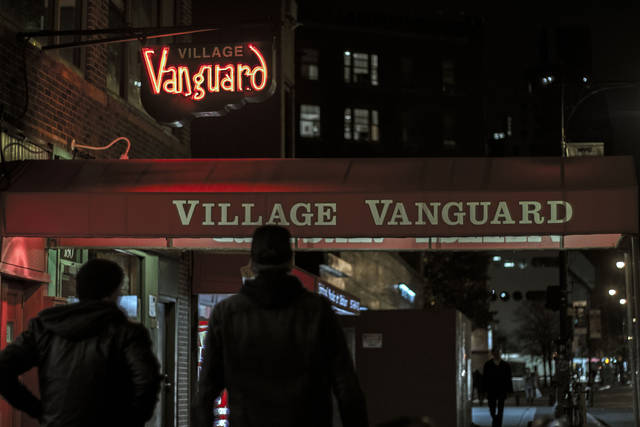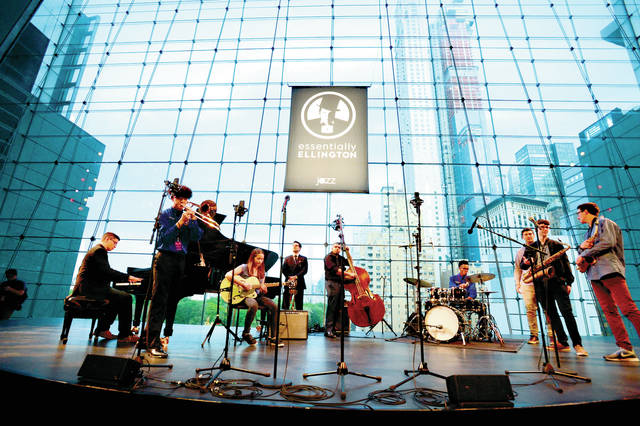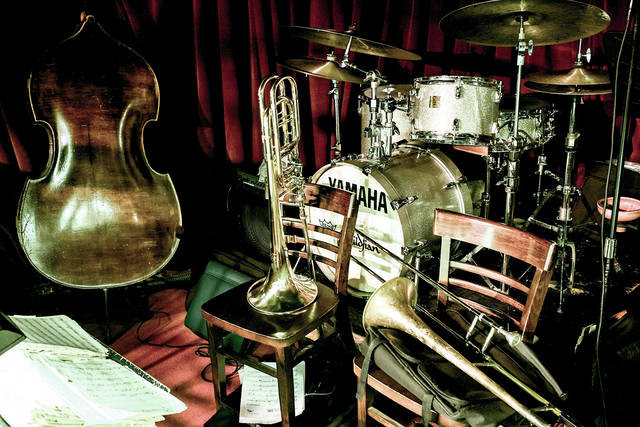Affordable music for the family in NYC? Try a jazz club


This undated photo provided by Jazz at Lincoln Center shows Essentially Ellington High School Jazz Band students participating in jazz performance instruction at Jazz at Lincoln Center in New York. New York has long been a city known for jazz. What’s less known is how kid- and family-friendly jazz performances can be. (Frank Stewart/Jazz at Lincoln Center via AP)

This undated photo provided by the Village Vanguard shows various instruments on the stage at the club in New York ready for the Vanguard 16 piece Jazz orchestra. The orchestra has played at the Vanguard every Monday night since 1966 and is a New York City tradition. New York has long been a city known for jazz. What’s less known is how kid- and family-friendly jazz performances can be. (Michael Larson/Village Vanguard via AP)
NEW YORK New York has long been a city known for jazz. Whats less well-known is how kid- and family-friendly jazz performances here can be.
NEW YORK — New York has long been a city known for jazz. What’s less well-known is how kid- and family-friendly jazz performances here can be.
Many performers have day jobs as educators, and although many venues are nightclubs, there are jazz performances where even toddlers are welcome.
ADVERTISING
“When I was a kid, the Vanguard was an extension of my home. It was not only smoky, it was noisy. Now? Forget it. Make a peep and the noise police will shush you,” says Deborah Gordon, general manager of the Village Vanguard, opened by her father in 1935. “It was a rough-and-tumble place when I was a kid, and 13-year-olds definitely weren’t allowed in. You’d have to hang out on the stairs if you wanted to listen.”
A lot has changed. Today, the Vanguard is non-smoking and cleaner, and the minimum age to attend a performance is 13. But Gordon says not all kids are ready at that age for jazz (she says she wasn’t). Visitors should keep a few things in mind before making a reservation:
“Do your homework first about who’s playing, and see if it’s what you want to hear,” she says. Also, no food is served, and the place is, still, a nightclub.
The Blue Note, Smalls Jazz Club, Birdland Jazz Club and the Jazz Standard have no minimum age and welcome well-behaved children accompanied by adults. The minimum age at Dizzy’s Club Coca-Cola is 7, and the Jazz Standard hosts a “Jazz for Kids” program on Sundays.
As for types of jazz, Todd Stoll, Jazz at Lincoln Center’s vice president of education, recommends vocalists and big band music as a good entry point for kids. He urges families to explore Jazz at Lincoln Center’s YouTube channel, featuring videos explaining improvisation and various jazz artists and genres.
Jazz at Lincoln Center features performances for kids as young as 8 months.
“We call them Family Jazz Parties, and we have six to eight of them a year. They’re family jazz concerts for a kid and a caregiver, with jazz that is very digestible for kids of that age group (8 months to 5 years) while also enjoyable for parents, held in a carpeted venue where kids can move around,” Stoll says. In addition, visitors to New York can buy tickets to a single WeBop jazz appreciation class for a young person and a caregiver.
Jazz at Lincoln Center also offers two family-oriented concerts a year, created by Wynton Marsalis and inspired by a format begun by Leonard Bernstein in the 1950s. The concerts combine music and education around a specific concept, genre or important figure.
“Older than that, and most kids are really ready to check out Dizzy’s or the Vanguard or whatever other place they’re interested in going,” Stoll said. “Just do some research before you go. It’s not a musical or a pop concert, it’s fine art. It doesn’t pander.”
Jazz, says Marsalis, “demands that we develop our hearing. It’s our job to empower kids and to teach them to listen and to hear. We should encourage them to get with the harmony, get to the piano, learn three or four basic chords, a blues — it’s a great tool to encourage hearing.”
Stoll says that delving into jazz is also a great way to better appreciate New York City.
“The first jazz recording ever made was in New York in 1917, just about every jazz great came to New York to make their name here, and the vibe and feeling of New York is still a jazz vibe. New York sweats jazz,” he says.
And unlike many Broadway musicals, jazz performances tend to be reasonably priced and readily accessible without much advance planning.
“It’s a pretty good bang for your buck. We try to keep admission to $35 with a one-drink minimum,” says Gordon, of the Vanguard.
Not only can a family of four sit right up front at a jazz concert for around the price of a single Broadway ticket, but tickets to jazz clubs can often be had the day of a performance. Reservations to shows are made online, and clubs generally have first-come first-served seating. Jazz at Lincoln Center offers student discounts in their concert halls and at Dizzy’s Club Coca-Cola, as do some other places.
“With kids, you definitely want to get them right up close by the drums, where they can see all that’s going on. It really blows them away,” says Gordon. Arrive well before showtime if you want the best seats.
There’s an energy to improvisation and live music, and between a band and an audience in intimate settings, Gordon says.
As for the Vanguard, a cozy basement venue known for its narrow red staircase and red-carpeted stage backed by red velvet curtains, Gordon jokes: “We are dedicatedly un-renovated. It takes a lot of work to keep it as shabby as we do. It looks pretty much like it did in the ’30s.”
Stoll says kids can learn a lot from jazz: “On an intellectual level, improvisation is the freedom and the importance of the individual voice. Swing is how that voice is related to a group. Blues is facing adversity with optimism. Those are three things we want kids to get from jazz. It also teaches us culturally about America, with lessons about race, gender and socio-economic disparity, if parents want to make it a lesson about that.”


